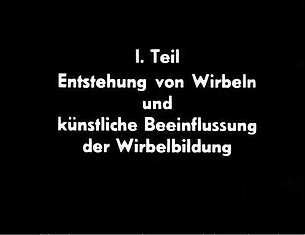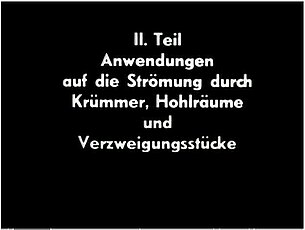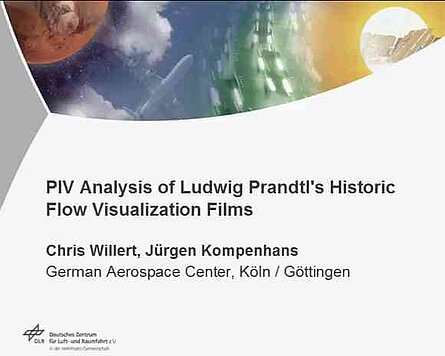Qualitative and quantitative visualization of unsteady flows – Movie by Ludwig Prandtl
Qualitative visualization - Movies
Around 1930 Ludwig Prandtl and his colleagues O. Tietjens and W. Müller of the Aerodynamische Versuchsanstalt Göttingen (AVA) published two films with visualizations of flows around surface piercing obstacles to illustrate the unsteady process of flow separation.
The contents of these movies is described in
- Entstehung von Wirbeln bei Wasserströmungen, Veröffentlichungen der Reichsstelle für den Unterrichtsfilm zu den Hochschulfilmen C1 und C2, 3 Seiten, Berlin 1932
A reprint of this description can be found on pages 817-818 of
- Tollmien W., Schlichting H., Görtler H., Riegels F.W. (1961) Entstehung von Wirbeln bei Wasserströmungen. In: Riegels F.W. (eds), Ludwig Prandtl Gesammelte Abhandlungen. Springer, Berlin, Heidelberg,
https://doi.org/10.1007/978-3-662-11836-8_67
The movies have been digitized by the Institut für Wissenschaftlichen Film, Göttingen in 2009 and are now available at the Technische Informationsbibliothek Hannover.

1. Entstehung von Wirbeln und künstliche Beeinflussung der Wirbelbildung,
https://doi.org/10.3203/IWF/C-1

2. Anwendungen auf die Strömung durch Krümmer, Hohlräume und Verzweigungsstücke,
https://doi.org/10.3203/IWF/C-2

Quantitative visualization - Movies
Because these visualizations were achieved by recording the motion of fine particles sprinkled onto the water surface in water channels the resulting images meet the relevant criteria of properly seeded recordings for particle image velocimetry (PIV). Processing these image data with modern PIV algorithms allows the visualization of flow quantities (e.g. vorticity) that were unavailable prior to the development of the PIV technique.
The PIV analysis of the original film sequences, which has been contributed to the "Gallery of Fluid Motion", 63rd Annual APS-DFD Meeting 2010, Long Beach (CA) is described in
- C. Willert, J. Kompenhans, PIV Analysis of Ludwig Prandtl's Historic Flow Visualization Films, 63rd Annual APS-DFD Meeting 2010, Long Beach (CA), http://elib.dlr.de/65708/1/PrandtlPIV_arXiv1010.3149v1.pdf

The accompanying fluid dynamics video consists of selected original film sequences overlaid with visualizations obtained through PIV processing. It is available for download at TIB Hannover
C. Willert, J. Kompenhans. Particle Image Velocimetry (PIV) analysis of Ludwig Prandtl‘s historic flow visualisation films, https://doi.org/10.5446/12719
It is obvious that movies provide better insight of unsteady flow phenomena than still photographs. However, in most cases (analog) movies can only display qualitative information.
By digitizing century old, high quality analog movies and making use of modern computers and evaluation algorithms, quantitative information can be extracted from archival material as well.
Nowadays the exchange of images and movies of flow visualization results in digitized format is possible world-wide within seconds. New experimental methods, based on quantitative flow visualization have become commonplace and facilitate close international scientific cooperation to gain new and deeper insight in complex unsteady flow phenomena.
Contents provided by Chris Willert and Juergen Kompenhans, 20171012

